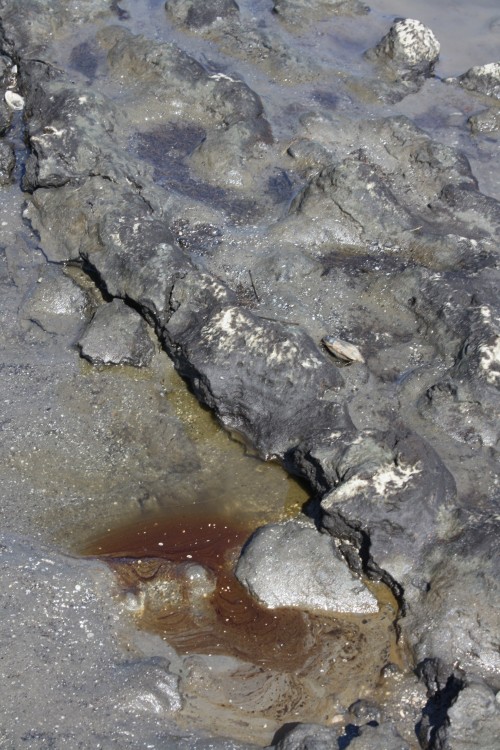
Happy 100, Mr. LaCoste – Local becomes a centenarian
September 12, 2012St. Mary added to FEMA assistance list
September 12, 2012Large chunks of weathered oil discovered along Elmer’s Island in the aftermath of Hurricane Isaac prompted the closure of coastal waters along Fourchon Beach last week, state officials announced.
The state Coastal Protection and Restoration Authority released photographs of oil mats and tar balls found along the Elmer’s Island shoreline last Friday. Officials have found mats up to the length of three parked cars, officials said.
Garret Graves, the authority’s chairman, said preliminary testing has linked the oil to the discharge following the 2010 BP Deepwater Horizon blowout that killed 11 people and dumped approximately 3.5 million of barrels of oil into the Gulf of Mexico.
“We’ve seen oil mats in excess of 100 feet in some areas, very deep and very wide,” Graves said. “There’s no other likely source of this oil other than BP.”
The oily products – often described as balls, patties and mats– that surfaced do so in one of two scenarios, Graves said. One is that submerged “oil mats” in the Gulf are broken apart by wave energy, such as in the case of storms, and pieces are carried to shore. The second instance is when near-shore oil mats are uncovered as waves remove sand.
A reconnaissance team reported seeing the heaviest sheen “since the peak of the spill” near the Middle Ground wetlands area in Plaquemines Parish, but the extent of oily material entering the marsh is not yet known, Graves said. Tar balls and oily products have also been reported on Grand Isle and Grande Terre, Graves said.
BP, principal of the Macondo prospect well that blew out, has resumed cleanup efforts in Louisiana, Alabama, Florida and the Mississippi barrier islands, spokesman Ray Melick said in a statement emailed on Monday.
“Gulf Coast Incident Management Team (GCIMT) assessment teams have been on the ground in all four states and continue to engage in shoreline assessment in the aftermath of Hurricane Isaac,” the statement says. “Approximately 450 clean-up workers are actively engaged across the four states and are following removal protocols established by the FOSC (Federal On-Scene Coordinator, which is the U.S. Coast Guard) and appropriate state and federal authorities.”
Last week, the state Department of Wildlife and Fisheries announced the closure of coastal waters between Belle Pass’s eastern bank and Caminada Pass’s western bank, which includes most of Fourchon Beach and Elmer’s Island. The closure extends one mile into the Gulf of Mexico.
Commercial and recreational fishing are prohibited in the area, and only recreational and charter rod-and-reel fishing are permitted in the zone.
Retailers or wholesalers who hold a special bait dealer’s permit and who harvest live bait for exclusive sale to recreational fishermen are not impacted.
LDWF will partner with the state’s Department of Environmental Quality to determine the tar balls’ and tar mats’ extent, source and impacts.
Forrest Travirca, a retired LDWF enforcement agent who has inspected a private landowner’s Fourchon Beach property since 1999, said Isaac uncovered a “substantial amount” of tar “patties” along the beach. Travirca said he’s “absolutely” certain the patties stem from the Macondo blowout.
“I have been traveling this beach since 1973, and I had never seen a quote, unquote tar ball (until the Macondo blowout),” he said. “Every single piece of oil was sampled and came back tested by BP as having the footprint of MC-252 (the oil that came from the Macondo well). Never has any collected oil been identified from any other source other than MC-252.”
BP crews responded to the beach on Monday, and Isaac did not push any oily product into the property’s marshes, Travirca said.
The field inspector said he has taken 6,000 photographs since oil began to wash ashore on May 20, 2010. He has claimed for months that residual oil remains buried beneath layers of sand along the beach.
The Edward Wisner Donation, which owns 9 ½ miles of the shoreline and about 35,000 acres inland, is engaged in a legal battle with BP over spill-related damages to its Fourchon Beach property.
Construction on the state-funded Caminada Headlands project is expected to begin in December. The $70 million project will utilize 2.8 million cubic yards of sand to restore 5 miles of beach between Belle Pass and Caminada Pass, state officials have said.
CPRA is the project’s sponsor. Graves said that because of documented reports that oil remains beneath the sand where tons more will be dumped, state employees are taking core samples to ensure all recoverable oil is removed before the project starts, a responsibility he said should fall on BP, not local officials.
“The spill was almost two and a half years ago. The fact that this burden is being put on us right now, it’s just ridiculous,” Graves said. “BP should have been doing all of this, they could have been doing all of this well over a year ago instead of being entirely in this reactive posture where we, in effect, the state has to find the oil, the parishes have to find the oil, the owners like Wisner have to find the oil in order to get BP out there to clean it up.”
Weathered oil could contain polycyclic aromatic hydrocarbons, environmental pollutants that could pose human health risks. Anyone who discovers oily products is asked to report the sighting to the National Response Center at (800) 424-8802 or the 24-hour Louisiana Emergency Hazardous Materials Hotline at (877) 925-6595.
Weathered oil rests on Elmer’s Island. The sighting of chucks of oily products prompted state officials to close coastal waters along Fourchon Beach last week.









